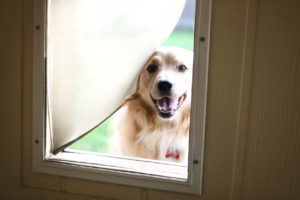[…]]]>
 Long gone are the days when most pets languished outdoors, enduring the elements as best they could, summer or winter. These days, the more enlightened pet owner understands that pets feel weather as keenly as we do, and that they live longer and in better health if they can live indoors in temperature-controlled conditions. Now that winter is here (such as it is in Yuma), it is important to know a bit about optimum indoor heating and other issues that concern pets.
Long gone are the days when most pets languished outdoors, enduring the elements as best they could, summer or winter. These days, the more enlightened pet owner understands that pets feel weather as keenly as we do, and that they live longer and in better health if they can live indoors in temperature-controlled conditions. Now that winter is here (such as it is in Yuma), it is important to know a bit about optimum indoor heating and other issues that concern pets.
Best Indoor Conditions for Pets
While you probably set the temperature to suit you and the human members of your household, you undoubtedly have some concerns for your pets as well. If you’ve ever had a dog that pants continuously when the temperature seems fine to you, or dogs that shiver and cats that seek to burrow under covers, you know how difficult it can be to get everything just right for all, human and animal.
The fact is, just like us, pets have differing needs. Generally, smaller animals, those with thinner coats and those with less body fat tend to get colder. Older and very young pets also may require higher temperatures to stay healthy. Likewise, animals with joint issues and infections may also do better under warmer conditions.
When You’re Away
Never turn off the air conditioner or turn it up too high in the warm months while you’re away in the belief your pets can manage. When cats and dogs have to live outdoors, they often try to find a way to keep cool or warm by burrowing into the ground or under leaves in a cool spot; in your home, that obviously won’t be possible. Maintain a temperature between 65-75 degrees year round.
When vacationing, you should make sure your pet sitter has clear instructions about initiating repairs if the HVAC system goes on the blink while you’re away. Also, have a plan where the pets can go in this type of emergency till you return.
For more on pets and indoor heating and cooling, contact Hansberger Refrigeration and Electric Company.
Our goal is to help educate our customers in Yuma, Arizona about energy and home comfort issues (specific to HVAC systems). For more information about other HVAC topics, download our free Home Comfort Guide or call us at 928-723-3183.
]]>[…]]]>
 Can’t wait to get away for summer vacation? We understand, but take your time and be sure you’ve made that all-important list for your house or pet sitter before you go.
Can’t wait to get away for summer vacation? We understand, but take your time and be sure you’ve made that all-important list for your house or pet sitter before you go.
You can’t expect your sitter to know how things should run unless you share the information, and there’s no better way to get your point across than by writing it down in the form of explicit instructions. Explain about alarms; bringing in the mail, packages, and newspapers; monitoring the sprinkler system; and making sure timed lighting comes on every night.
And don’t forget to include some instructions regarding the use of the HVAC system on your sitter checklist. Some suggestions follow.
Monitoring the A/C
In our climate, don’t even think about leaving home without the A/C on. Even if you don’t have pets, you can cause major damage to plants and electronics if it gets too hot in your home. So turn the thermostat up a few degrees, but by all means, leave the A/C on. This will also make it more comfortable if you have a drop-in sitter.
Be sure the sitter understands how to operate the air conditioner. Go over the controls, and explain how the thermostat works — particularly how to change the temperature setting if need be. Also, explain what to look for as signs of HVAC malfunction, such as these:
- Dripping sounds that indicate a clogged condensate drain. You don’t want to come back to a flooded home.
- A/C fails to cool home.
- Knocking noises in the outdoor or indoor unit.
If any of these issues occurs, the sitter should know what you want to do — whether it is to contact you so you can make arrangements for repairs, or if you’re out of reach, the name of your HVAC consultant. You may want to contact your company ahead of time and explain that the sitter is authorized to notify them in case of malfunction, and to let the technician in for repairs.
For more on creating a sitter checklist that highlights monitoring the air conditioner, contact Hansberger Refrigeration and Electric Company.
Our goal is to help educate our customers in Yuma, Arizona about energy and home comfort issues (specific to HVAC systems). For more information about other HVAC topics, download our free Home Comfort Guide or call us at 928-723-3183.
]]>[…]]]>
 Pet owners appreciate the freedom that pet doors offer, but for all their convenience and benefits, they’re not always energy efficient. While the ability of the door flap has to resist heat transfer, the greater concern is air leaks around the flap and the pet door’s frame.
Pet owners appreciate the freedom that pet doors offer, but for all their convenience and benefits, they’re not always energy efficient. While the ability of the door flap has to resist heat transfer, the greater concern is air leaks around the flap and the pet door’s frame.
When choosing a pet door, keep these characteristics in mind:
- Dual-flaps. When installing a pet door into a wall, make sure it has enough space between the interior and exterior sides to provide an insulating air space. Doors with flaps on the inside and outside do the best job at preventing air infiltration and heat exchange.
- Sliding glass door inserts. Manufacturers use glass above the pet flap and they’re designed to fit tightly into the opening. They are available as dual-pane inserts, something you might want to consider if the sun shines on the window during the summer. A low-e, dual-pane insert keeps the most heat out.
- Weatherstripping around the flap. The weatherstripping should be thick enough to keep a reasonably tight seal to prevent air from entering or leaving when the door is in its closed position.
- Magnetic door flaps are more likely to snap shut than those that use simple hinges.
- Locking doors. Moderately priced to expensive pet doors are available that use locks in a variety of ways. They could have manual levers, magnets, or use electronic signals to open and automatically close. Besides being more energy efficient, they also prevent intrusions from unwanted animals or humans.
Installing the Doors
Unless you have some woodworking skills and tools, you may want to hire someone to install the door for you. You might have to cut through an exterior wall or door, neither of which is without its challenges. A professional will be sure that the door is straight and level, and that it’s adequately insulated and caulked where it needs to be for maximum energy efficiency.
For a complete home load evaluation and more energy-efficient HVAC options, contact the pros at Hansberger Refrigeration and Electric Company, providing HVAC services for Yuma-area homeowners.
Our goal is to help educate our customers in Yuma, Arizona about energy and home comfort issues (specific to HVAC systems). For more information about other HVAC topics, download our free Home Comfort Guide or call us at 928-723-3183.
]]>